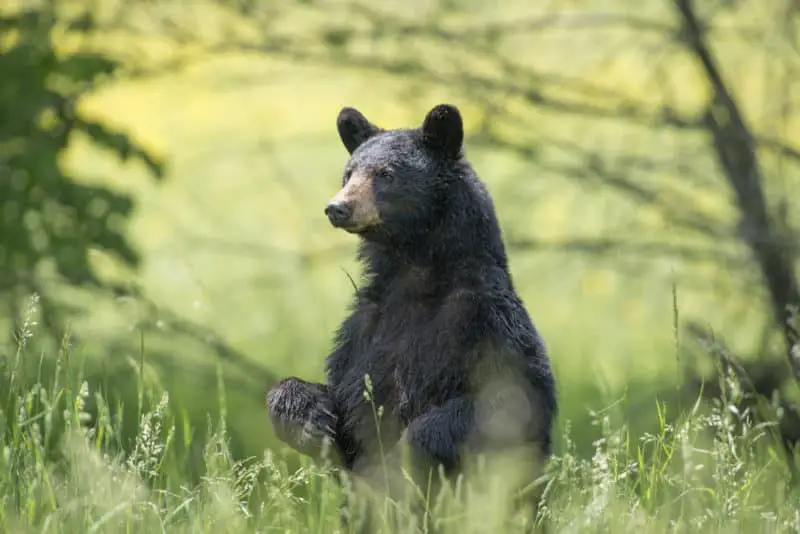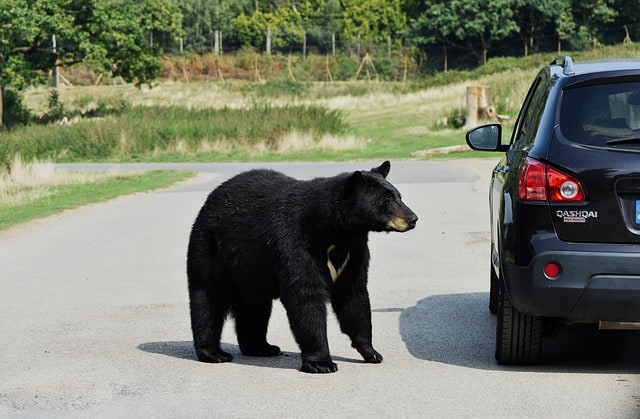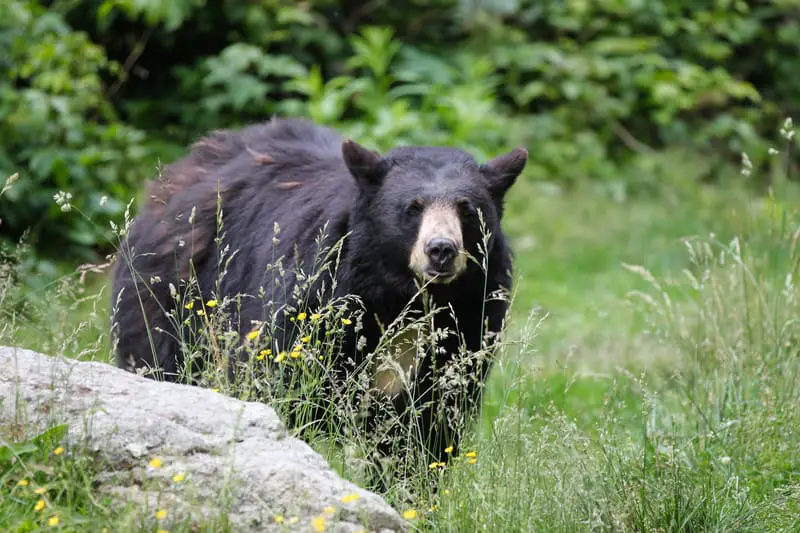Connecticut is home to a rapidly growing American black bear population of 1,000 to 1,200 animals.
Historically, there were black bears in Connecticut before the area was settled by European colonists. However, they were expatriated from the state by the mid-1800s.
As many farms in the region were abandoned beginning in the late 1800s, the state began to be reforested. The return of forest land, in part, facilitated the return of the black bear to the state.
In the 1980s, the Connecticut Department of Energy and Environmental Protection Wildlife Division established that there was again a breeding population of black bears in the state. This population has expanded ever since.
An expanding black bear population in a state that has one of the densest human populations in the United States presents Connecticut’s wildlife officials with some unique challenges.
Connecticut’s neighbors, New York, Rhode Island, and Massachusetts, also have expanding black bear populations and to some extent, are facing similar challenges.

Black bears in Connecticut
The black bear’s scientific name, Ursus americanus, means American bear in English. They are the most common and well-known bears native to North America. Their range begins in Alaska and northern Canada and extends south into central Mexico. Only 9 of the contiguous U.S. states don’t have breeding black bear populations.
According to the Connecticut State Department of Energy and Environmental Protection, the majority of Connecticut’s bear population lives in the northwest corner of the state. However, bears are taking up all available habitat within the state. They’re also becoming regular residents of Connecticut towns.
According to the University of Connecticut School of Law, in 2016, there were bear sightings reported in 140 of Connecticut’s 169 towns. That was 6 years ago, and the bear population has expanded since then.
In 2022, there have been sightings in 156 of the state’s 169 municipalities.
Although there haven’t been any reported fatal bear attacks, human-bear interactions and bears exhibiting aggressive behavior toward Connecticut residents are becoming more commonplace. For example, in October, a ten-year-old boy in Morris, Connecticut,, was mauled by a black bear in his grandparent’s backyard. Below is a quote from Boston.com.
“State biologist Jenny Dixon said the risk of negative bear-human interactions is increasing as Connecticut’s expanding bear population becomes acclimated to humans and develops a taste for their food.”
There are also economic repercussions with Connecticut’s unchecked population of bears. Cornwall, Connecticut, farmer Buddy Hurlburt states that he loses thousands of dollars worth of corn in his fields every year due to bear depredation. See
Currently, there is a statewide ban on hunting or trapping bears in Connecticut. Some wildlife experts recommend a limited bear hunt to help control the growing number of bears.
Opponents of a bear hunt favor nonlethal controls such as education about not leaving food out and aversive conditioning with paintball and rubber bullets. See

What do black bears look like?
Adult black bears are anywhere from 50 to 85 inches long from the tip of the nose to the tip of the tail. Their average height is around 30 inches at the shoulder. The normal black bear’s weight range is from 140 to 400 pounds. However, males can be up to 70% larger than females, and some giant-sized individuals weigh over 800 pounds. The heaviest black bear ever harvested came from Pike County, Pennsylvania. It weighed 875 pounds.
Even though they are named black bears, their colors can vary from black, blue-grey, cinnamon, brown, and blue-black, and on infrequent occasions, a black bear can even be white. Although most Connecticut bears are black, a small percentage of them are cinnamon-colored. Some black bears have a V-shaped white patch on their chest.
They have long brown snouts, short tails, and small brown eyes, although their eyes are blue at birth. Black bears lack the shoulder hump that brown bears or grizzly bears have. In areas that both species inhabit, the hump, or the lack thereof, is a distinguishing feature. Any wild bear in Connecticut will be a black bear, though.
How to make your property less attractive to bears
According to DEEP Wildlife Division Director Jenny Dickson, 2022 has been a record year for Connecticut bears breaking into people’s homes. As of Sept. 29th, there had already been 65 bear home entries.
In drought years, there is a higher likelihood of potential conflicts between bears and humans. Bear sightings in rural and even suburban and urban areas increase significantly in times of drought. Drought-stressed bears might wander into areas with higher human populations in search of alternative food sources.
Another factor that can potentially cause bears to wander is the time of year. When female bears or sows begin to kick their previous year’s cubs off in early summer, young bears, particularly young male bears, sometimes wander great distances looking to establish their own home ranges. At this time, occasionally, they wander into residential areas as they search for their own territory.
Besides being dangerous apex predators, bears can potentially cause significant damage to your home and or vehicles. For example, if a black bear smells food in your parked car, it is capable of tearing the door off to get to it.
If you live in bear country, the following bear precautions will make your property less attractive to wandering bears.
Pet food
It’s a bad idea to feed your outside pets more than they can efficiently clean up before dark. It’s also a bad idea to store your pet food outside. If you store your pet food outside, keep it in a bear-proof container.
Barbeque grills
Backyard barbecue grills are bear attractors. You Should clean your barbecue grill after every use and store it inside. If you live on a large property, dispose of your grease drippings and food waste in an area far away from your home. For the majority of people, though, who don’t live on a large acreage, the best thing to do is to store your grease drippings and meat scraps in the refrigerator until garbage day and then throw it away just before the garbage truck comes.
Trash cans
You should also store your garbage cans indoors and clean and disinfect them regularly.
Compost piles
Garden compost also has the potential to attract bears. Unless you can store your compost under cover, you probably shouldn’t be composting in bear range.

Vehicles
Keep all food or empty containers that have had food in them out of your vehicles. Bears have a powerful sense of smell. Furthermore, as I mentioned earlier, an adult black bear is capable of bending your car door in half if it decides it wants to get inside.
Use electric fencing.
If you have a vegetable garden, a chicken coop, small farm animals, fruit trees, or any other outside bear attractants, you should conder using electric fencing to keep the bears at bay.
Bird feeders will attract bears.
Bears love to raid bird feeders, whether that be hummingbird feeders or ones that dispense out bird seed. They especially like the molded blocks of suet with birdseed inside.
If you live in bear country, it’s not a good idea to put out birdseed during the warmer months. Wait to feed the birds until December through late March when bears are hibernating.
Never feed the bears.
A huge mistake that people sometimes make is to put food out to attract bears on purpose. When you do that, you create a situation that is beyond your control.
When bears begin to associate humans with food, they lose any fear of humans that they might have had. They also might act out aggressively if they decide that you’re not giving them the food that they want and are accustomed to. They might also take that frustration out on your neighbor or, worse yet, your neighbor’s children. Look at the article found here for an example of what I’m talking about.
The best way to make a wild bear into a nuisance bear is to feed it. When a bear decides it’s easier to forage on human food rather than natural foods, the chances increase that it will have to be euthanized because it poses a danger to humans.
Bear encounter
The first time you encounter a bear on your property, don’t make it feel welcome. It’s important to harass it. While keeping a safe distance, make loud noises such as yelling, banging pots or pans, or honking an air horn to discourage further unwanted visits. You should never encourage bears to stay on your property. Keeping bears wild lessens the chance of a future dangerous situation.
Are black bears dangerous?
The knee-jerk response to that question is that black bears are timid, cautious animals; they’re more afraid of you than you are of them. etc.… All that is true most of the time. However, that’s only most of the time.
The following is from the Krebs Creek article titled Are Black Bears Dangerous to Humans?
“Black bears are not aggressive generally. They’re omnivores, which means their diet includes plant material but also meat. At times, black bears’ diets have been documented to consist of 96% plant material. This makes them one of the least predacious of all carnivores. However unaggressive they might be most of the time, black bears are still dangerous. In fact, at least one person is killed somewhere in North America each year by a black bear.
From 2001 through 2021, Black Bears killed twenty-eight people in North America. “
88% of fatal black bear attacks are perpetrated in late summer or fall by predatory lone male bears; not mother bears with cubs.
In the late summer and early fall, bears go through a period of hyperphagia. The reason being that they are packing on calories to see them through their winter hibernation. An average adult black bear takes in 5,000 to 8000 calories per day in the springtime and summer. Beginning in the late summer, their average caloric intake jumps up to 20,000 calories per day.
Put in another way, yes, black bears do kill people in rare instances, and 88% of these rare attacks are carried out by a hungry male bear.
The preceding information isn’t intended to scare you so much as it’s intended to offer some sense of reality.
Maybe it’ll make somebody think twice before they feed a black bear on their property. Here’s one parting link on the subject
Recent Posts
The only venomous snakes in Washington State are Northern Pacific Rattlesnakes. The Northern Pacific Rattlesnake (Crotalus oreganus oreganus) is a sub-species of the Western Rattlesnake. Anyone...
Skunks are not classified as true hibernators. But they go into a state of torpor when the weather gets cold. Skunks are light sleep hibernators, along with opossums, bears, and raccoons. ...

